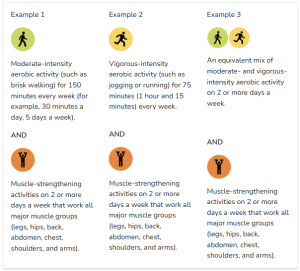Activity Guidelines for Physical Activity
January 28, 2025
Regular physical activity is essential for maintaining and improving overall health. The Centers for Disease Control and Prevention (CDC) provides comprehensive guidelines to help individuals understand the types and amounts of exercise needed at different life stages. These recommendations are designed to enhance well-being and reduce the risk of chronic diseases.
Benefits of Physical Activity
Engaging in regular physical activity offers numerous immediate and long-term health benefits, including:
- Improved sleep quality
- Enhanced cognitive function
- Reduced risk of chronic diseases such as heart disease, diabetes, and certain cancers
- Better weight management
- Strengthened bones and muscles
- Improved mental health and mood
These benefits apply to people of all ages and backgrounds.
Guidelines for Different Age Groups
The CDC outlines specific physical activity recommendations tailored to various age groups:
Children and Adolescents (Ages 6-17):
- Daily Activity: At least 60 minutes of moderate-to-vigorous physical activity.
- Aerobic Exercise: Most of the daily 60 minutes should be either moderate- or vigorous-intensity aerobic activity and should include vigorous-intensity physical activity on at least 3 days a week.
- Muscle-Strengthening: As part of their 60 minutes or more of daily physical activity, children and adolescents should include muscle-strengthening physical activity on at least 3 days a week.
- Bone-Strengthening: As part of their 60 minutes or more of daily physical activity, children and adolescents should include bone-strengthening physical activity on at least 3 days a week.
Adults (Ages 18-64):
- Aerobic Activity: At least 150 minutes to 300 minutes a week of moderate-intensity, or 75 minutes to 150 minutes a week of vigorous-intensity aerobic physical activity, or an equivalent combination. Preferably, aerobic activity should be spread throughout the week.
- Muscle-Strengthening: Adults should also do muscle-strengthening activities of moderate or greater intensity that involve all major muscle groups on 2 or more days a week, as these activities provide additional health benefits.
Older Adults (Ages 65 and Older):
- General Guidelines: Follow the adult guidelines as abilities and conditions allow.
- Balance Training: Include activities that improve balance, especially if at risk of falling.
- Chronic Conditions: Understand how chronic conditions affect the ability to do regular physical activity safely and adjust as necessary.
Tips for Incorporating Physical Activity
- Start Slowly: If new to exercise, begin with shorter sessions of moderate activity and gradually increase duration and intensity.
- Choose Enjoyable Activities: Engage in exercises that are enjoyable to increase the likelihood of maintaining a regular routine.
- Set Realistic Goals: Establish achievable goals to stay motivated and monitor progress.
- Use Available Resources: Utilize community resources such as parks, trails, and recreational facilities to stay active. Examples include Schram State Park, Mahoney State Park, Louisville State Park, Witte 24/7 Wellness, etc.

Remember, some physical activity is better than none. Incorporating even small amounts of exercise into your daily routine can lead to significant health benefits. Always consult with a healthcare provider before starting any new exercise program, especially if you have existing health conditions or concerns.
For more detailed information, visit the CDC’s Physical Activity Basics page.
References:
Physical Activity Guidelines for Americans | odphp.health.gov
Strategies for Physical Activity Through Community Design – CDC
Guidelines and Recommended Strategies | Physical Activity – CDC
Is Occupational Physical Activity Harmful to Health? – CDC Blogs
Adult Activity: An Overview | Physical Activity Basics – CDC
Dietary Guidelines for Americans | odphp.health.gov
Increasing Physical Activity | The Community Guide
American College of Sports Medicine
Physical Activity Guidelines – American College of Sports Medicine
Exercise and physical activity | National Institute on Aging
